Cloud Computing: Advantages, Disadvantages, and Impact Report
VerifiedAdded on 2019/10/31
|11
|2792
|337
Report
AI Summary
This business research report delves into the realm of cloud computing, exploring its core concepts, advantages, and disadvantages. The report begins with an introduction to cloud computing, defining it as a network of remote servers used for data management, storage, and processing. It then outlines the project's objectives, which include determining the benefits of cloud computing investments, analyzing its impact on businesses of all sizes, and identifying major beneficiaries. The project scope focuses on the increasing use of cloud computing and its implications for businesses. A comprehensive literature review follows, summarizing previous research on cloud computing, its advantages such as cost savings, speed, productivity, and reliability, and its disadvantages, including unsuitability for certain applications, connectivity issues, security concerns, and customer support challenges. The research design employs a qualitative descriptive method, with data collected from secondary sources. The report addresses research questions related to the benefits of cloud computing investment and its impact on businesses of different sizes. The report concludes with a time schedule and references.
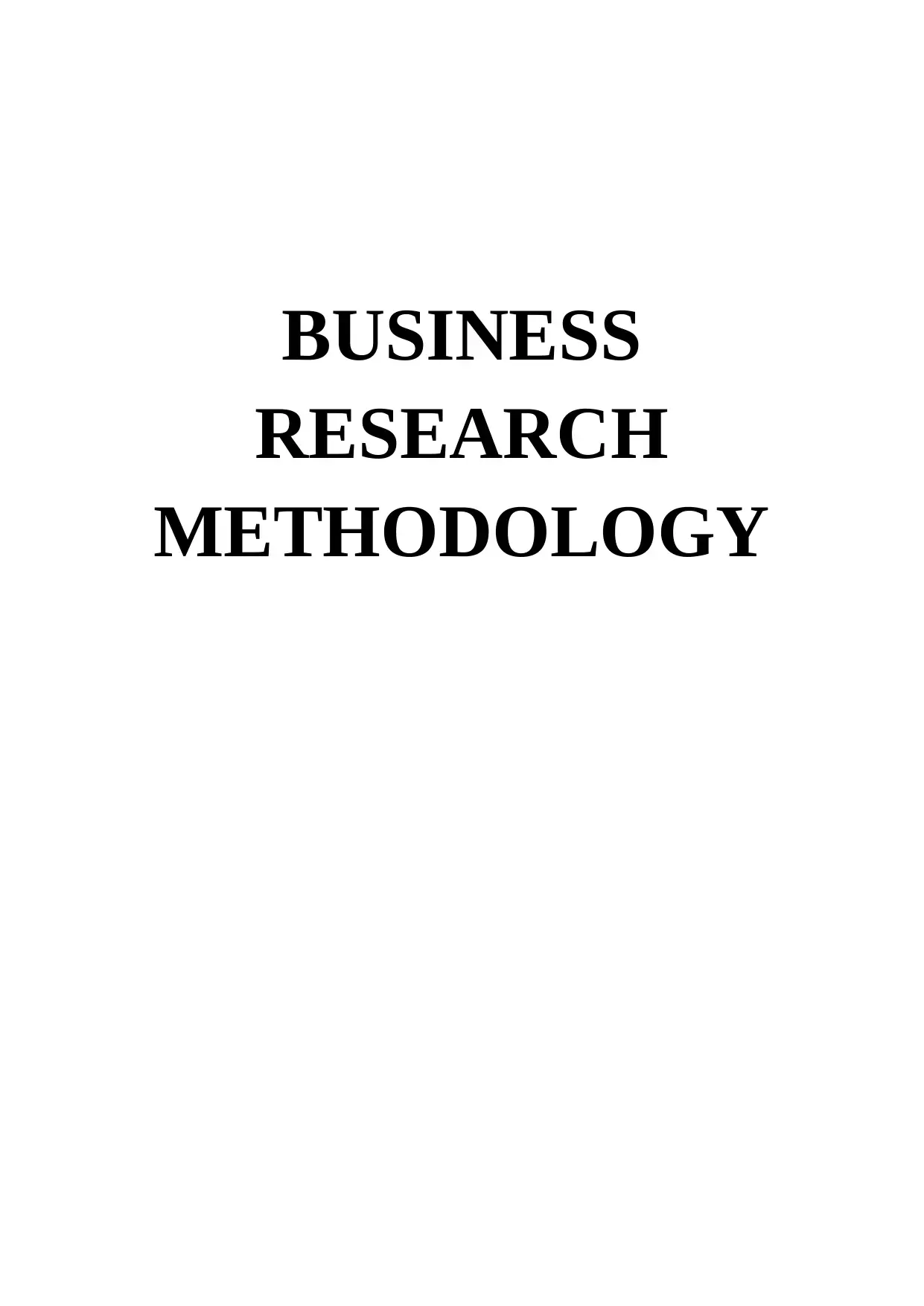
BUSINESS
RESEARCH
METHODOLOGY
RESEARCH
METHODOLOGY
Paraphrase This Document
Need a fresh take? Get an instant paraphrase of this document with our AI Paraphraser
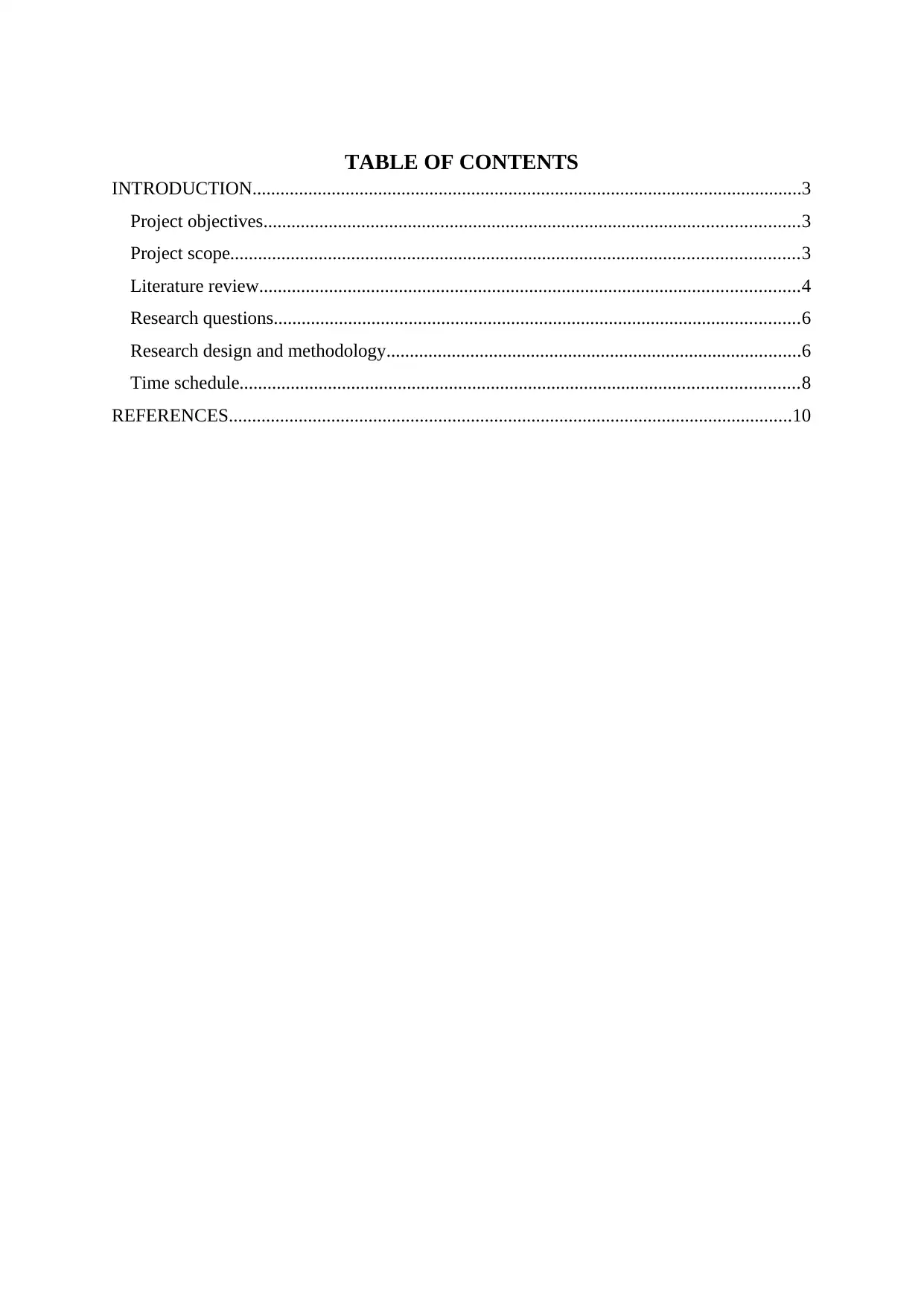
TABLE OF CONTENTS
INTRODUCTION......................................................................................................................3
Project objectives...................................................................................................................3
Project scope..........................................................................................................................3
Literature review....................................................................................................................4
Research questions.................................................................................................................6
Research design and methodology.........................................................................................6
Time schedule........................................................................................................................8
REFERENCES.........................................................................................................................10
INTRODUCTION......................................................................................................................3
Project objectives...................................................................................................................3
Project scope..........................................................................................................................3
Literature review....................................................................................................................4
Research questions.................................................................................................................6
Research design and methodology.........................................................................................6
Time schedule........................................................................................................................8
REFERENCES.........................................................................................................................10
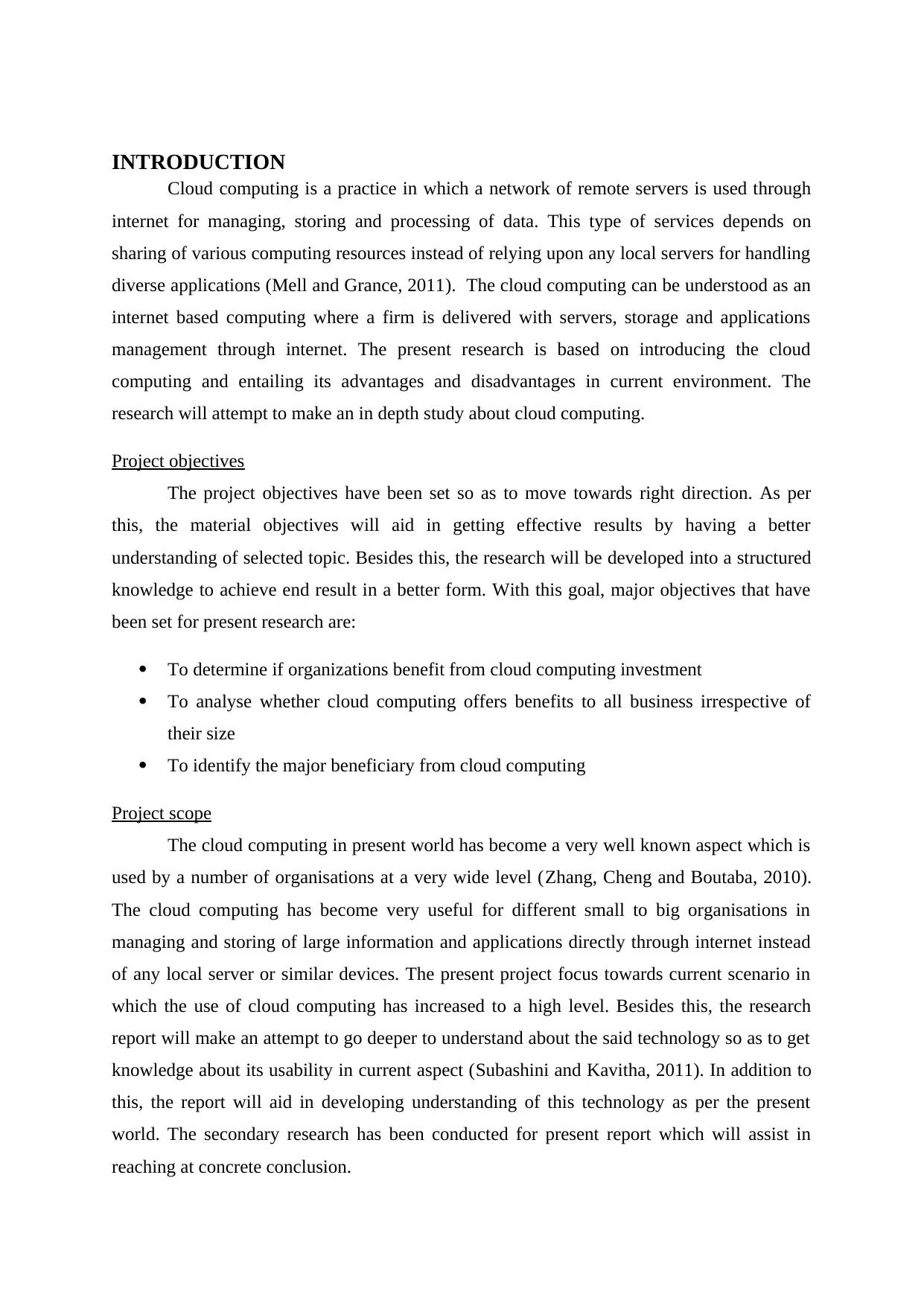
INTRODUCTION
Cloud computing is a practice in which a network of remote servers is used through
internet for managing, storing and processing of data. This type of services depends on
sharing of various computing resources instead of relying upon any local servers for handling
diverse applications (Mell and Grance, 2011). The cloud computing can be understood as an
internet based computing where a firm is delivered with servers, storage and applications
management through internet. The present research is based on introducing the cloud
computing and entailing its advantages and disadvantages in current environment. The
research will attempt to make an in depth study about cloud computing.
Project objectives
The project objectives have been set so as to move towards right direction. As per
this, the material objectives will aid in getting effective results by having a better
understanding of selected topic. Besides this, the research will be developed into a structured
knowledge to achieve end result in a better form. With this goal, major objectives that have
been set for present research are:
To determine if organizations benefit from cloud computing investment
To analyse whether cloud computing offers benefits to all business irrespective of
their size
To identify the major beneficiary from cloud computing
Project scope
The cloud computing in present world has become a very well known aspect which is
used by a number of organisations at a very wide level (Zhang, Cheng and Boutaba, 2010).
The cloud computing has become very useful for different small to big organisations in
managing and storing of large information and applications directly through internet instead
of any local server or similar devices. The present project focus towards current scenario in
which the use of cloud computing has increased to a high level. Besides this, the research
report will make an attempt to go deeper to understand about the said technology so as to get
knowledge about its usability in current aspect (Subashini and Kavitha, 2011). In addition to
this, the report will aid in developing understanding of this technology as per the present
world. The secondary research has been conducted for present report which will assist in
reaching at concrete conclusion.
Cloud computing is a practice in which a network of remote servers is used through
internet for managing, storing and processing of data. This type of services depends on
sharing of various computing resources instead of relying upon any local servers for handling
diverse applications (Mell and Grance, 2011). The cloud computing can be understood as an
internet based computing where a firm is delivered with servers, storage and applications
management through internet. The present research is based on introducing the cloud
computing and entailing its advantages and disadvantages in current environment. The
research will attempt to make an in depth study about cloud computing.
Project objectives
The project objectives have been set so as to move towards right direction. As per
this, the material objectives will aid in getting effective results by having a better
understanding of selected topic. Besides this, the research will be developed into a structured
knowledge to achieve end result in a better form. With this goal, major objectives that have
been set for present research are:
To determine if organizations benefit from cloud computing investment
To analyse whether cloud computing offers benefits to all business irrespective of
their size
To identify the major beneficiary from cloud computing
Project scope
The cloud computing in present world has become a very well known aspect which is
used by a number of organisations at a very wide level (Zhang, Cheng and Boutaba, 2010).
The cloud computing has become very useful for different small to big organisations in
managing and storing of large information and applications directly through internet instead
of any local server or similar devices. The present project focus towards current scenario in
which the use of cloud computing has increased to a high level. Besides this, the research
report will make an attempt to go deeper to understand about the said technology so as to get
knowledge about its usability in current aspect (Subashini and Kavitha, 2011). In addition to
this, the report will aid in developing understanding of this technology as per the present
world. The secondary research has been conducted for present report which will assist in
reaching at concrete conclusion.
⊘ This is a preview!⊘
Do you want full access?
Subscribe today to unlock all pages.

Trusted by 1+ million students worldwide
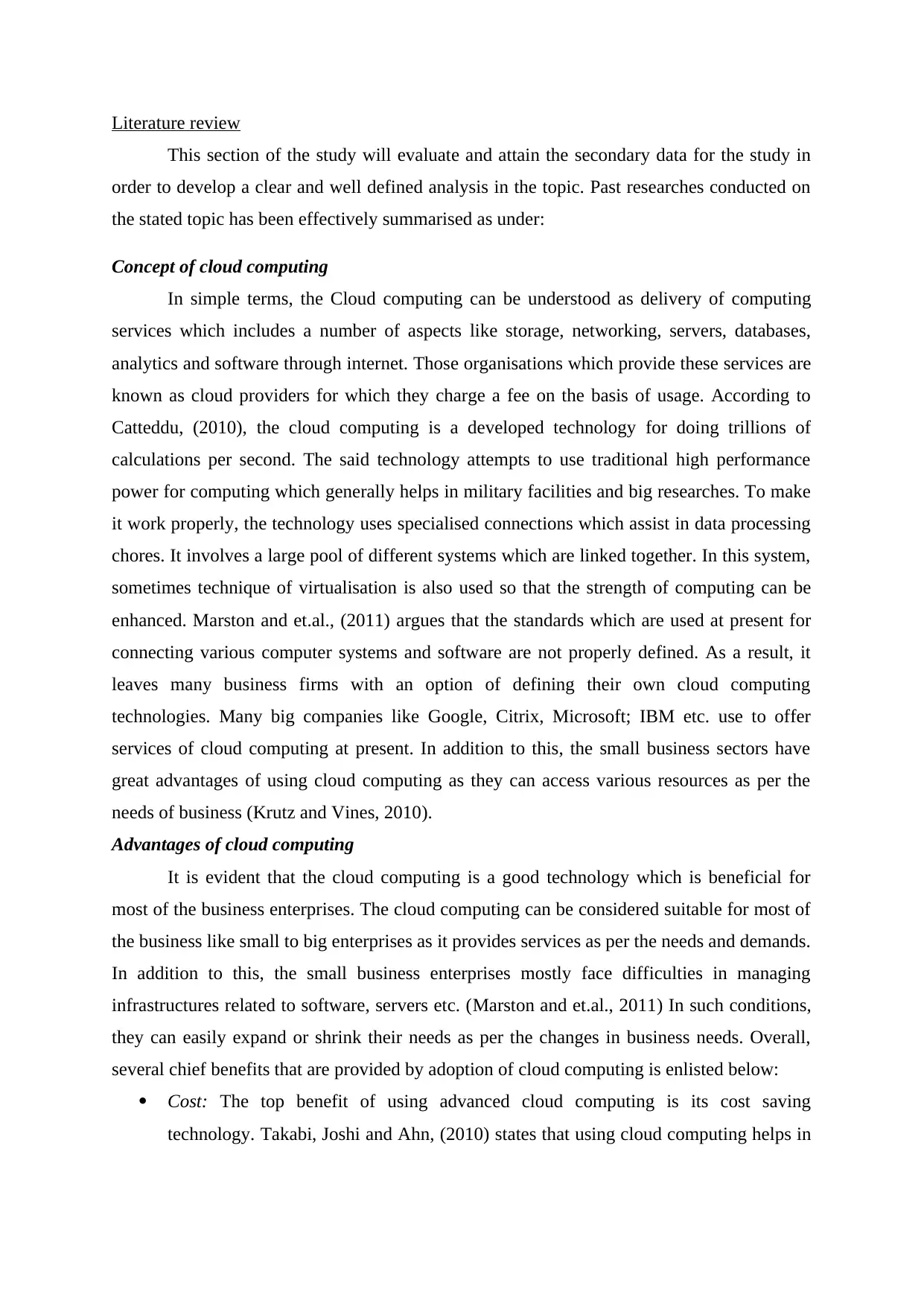
Literature review
This section of the study will evaluate and attain the secondary data for the study in
order to develop a clear and well defined analysis in the topic. Past researches conducted on
the stated topic has been effectively summarised as under:
Concept of cloud computing
In simple terms, the Cloud computing can be understood as delivery of computing
services which includes a number of aspects like storage, networking, servers, databases,
analytics and software through internet. Those organisations which provide these services are
known as cloud providers for which they charge a fee on the basis of usage. According to
Catteddu, (2010), the cloud computing is a developed technology for doing trillions of
calculations per second. The said technology attempts to use traditional high performance
power for computing which generally helps in military facilities and big researches. To make
it work properly, the technology uses specialised connections which assist in data processing
chores. It involves a large pool of different systems which are linked together. In this system,
sometimes technique of virtualisation is also used so that the strength of computing can be
enhanced. Marston and et.al., (2011) argues that the standards which are used at present for
connecting various computer systems and software are not properly defined. As a result, it
leaves many business firms with an option of defining their own cloud computing
technologies. Many big companies like Google, Citrix, Microsoft; IBM etc. use to offer
services of cloud computing at present. In addition to this, the small business sectors have
great advantages of using cloud computing as they can access various resources as per the
needs of business (Krutz and Vines, 2010).
Advantages of cloud computing
It is evident that the cloud computing is a good technology which is beneficial for
most of the business enterprises. The cloud computing can be considered suitable for most of
the business like small to big enterprises as it provides services as per the needs and demands.
In addition to this, the small business enterprises mostly face difficulties in managing
infrastructures related to software, servers etc. (Marston and et.al., 2011) In such conditions,
they can easily expand or shrink their needs as per the changes in business needs. Overall,
several chief benefits that are provided by adoption of cloud computing is enlisted below:
Cost: The top benefit of using advanced cloud computing is its cost saving
technology. Takabi, Joshi and Ahn, (2010) states that using cloud computing helps in
This section of the study will evaluate and attain the secondary data for the study in
order to develop a clear and well defined analysis in the topic. Past researches conducted on
the stated topic has been effectively summarised as under:
Concept of cloud computing
In simple terms, the Cloud computing can be understood as delivery of computing
services which includes a number of aspects like storage, networking, servers, databases,
analytics and software through internet. Those organisations which provide these services are
known as cloud providers for which they charge a fee on the basis of usage. According to
Catteddu, (2010), the cloud computing is a developed technology for doing trillions of
calculations per second. The said technology attempts to use traditional high performance
power for computing which generally helps in military facilities and big researches. To make
it work properly, the technology uses specialised connections which assist in data processing
chores. It involves a large pool of different systems which are linked together. In this system,
sometimes technique of virtualisation is also used so that the strength of computing can be
enhanced. Marston and et.al., (2011) argues that the standards which are used at present for
connecting various computer systems and software are not properly defined. As a result, it
leaves many business firms with an option of defining their own cloud computing
technologies. Many big companies like Google, Citrix, Microsoft; IBM etc. use to offer
services of cloud computing at present. In addition to this, the small business sectors have
great advantages of using cloud computing as they can access various resources as per the
needs of business (Krutz and Vines, 2010).
Advantages of cloud computing
It is evident that the cloud computing is a good technology which is beneficial for
most of the business enterprises. The cloud computing can be considered suitable for most of
the business like small to big enterprises as it provides services as per the needs and demands.
In addition to this, the small business enterprises mostly face difficulties in managing
infrastructures related to software, servers etc. (Marston and et.al., 2011) In such conditions,
they can easily expand or shrink their needs as per the changes in business needs. Overall,
several chief benefits that are provided by adoption of cloud computing is enlisted below:
Cost: The top benefit of using advanced cloud computing is its cost saving
technology. Takabi, Joshi and Ahn, (2010) states that using cloud computing helps in
Paraphrase This Document
Need a fresh take? Get an instant paraphrase of this document with our AI Paraphraser
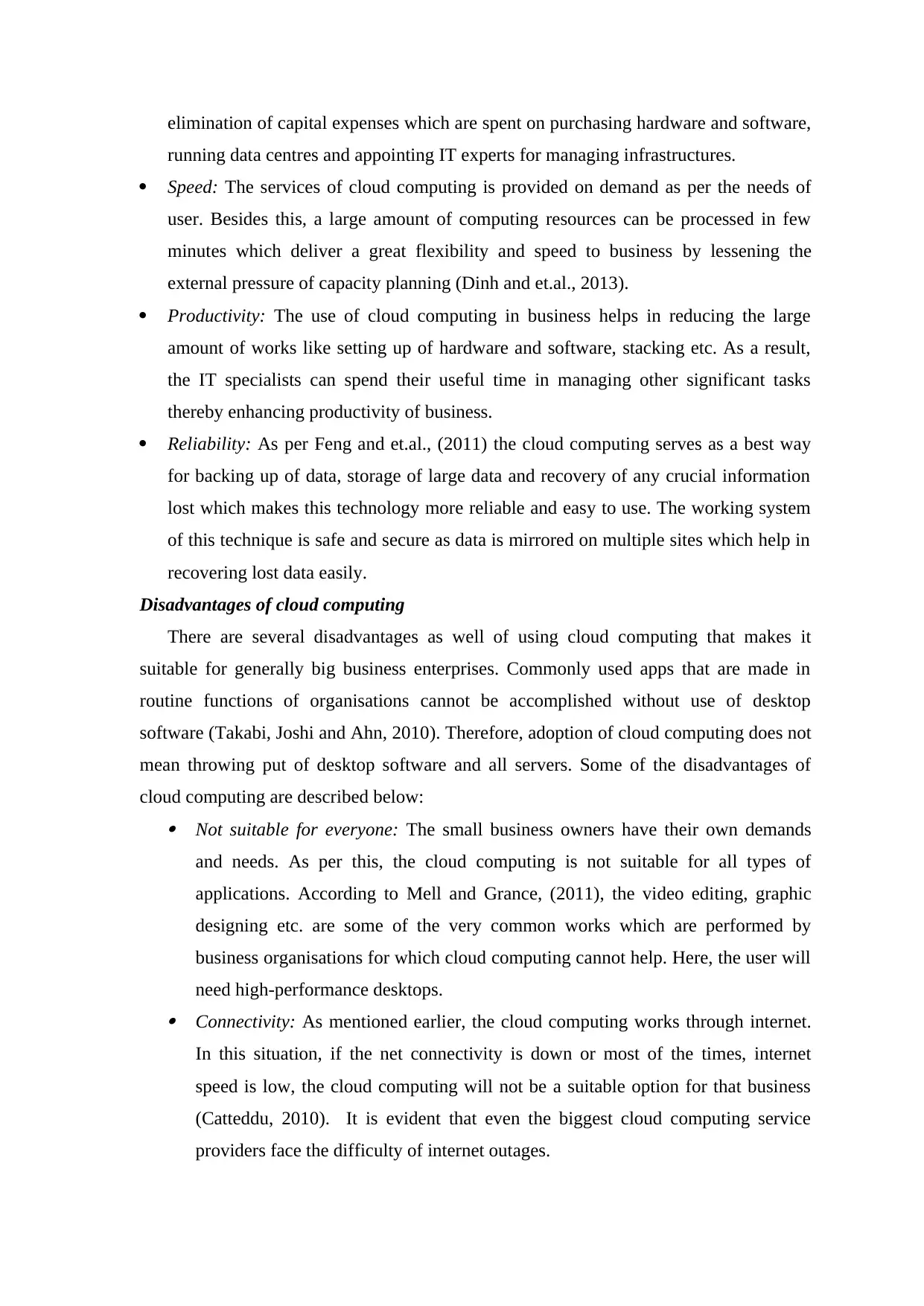
elimination of capital expenses which are spent on purchasing hardware and software,
running data centres and appointing IT experts for managing infrastructures.
Speed: The services of cloud computing is provided on demand as per the needs of
user. Besides this, a large amount of computing resources can be processed in few
minutes which deliver a great flexibility and speed to business by lessening the
external pressure of capacity planning (Dinh and et.al., 2013).
Productivity: The use of cloud computing in business helps in reducing the large
amount of works like setting up of hardware and software, stacking etc. As a result,
the IT specialists can spend their useful time in managing other significant tasks
thereby enhancing productivity of business.
Reliability: As per Feng and et.al., (2011) the cloud computing serves as a best way
for backing up of data, storage of large data and recovery of any crucial information
lost which makes this technology more reliable and easy to use. The working system
of this technique is safe and secure as data is mirrored on multiple sites which help in
recovering lost data easily.
Disadvantages of cloud computing
There are several disadvantages as well of using cloud computing that makes it
suitable for generally big business enterprises. Commonly used apps that are made in
routine functions of organisations cannot be accomplished without use of desktop
software (Takabi, Joshi and Ahn, 2010). Therefore, adoption of cloud computing does not
mean throwing put of desktop software and all servers. Some of the disadvantages of
cloud computing are described below:
Not suitable for everyone: The small business owners have their own demands
and needs. As per this, the cloud computing is not suitable for all types of
applications. According to Mell and Grance, (2011), the video editing, graphic
designing etc. are some of the very common works which are performed by
business organisations for which cloud computing cannot help. Here, the user will
need high-performance desktops.
Connectivity: As mentioned earlier, the cloud computing works through internet.
In this situation, if the net connectivity is down or most of the times, internet
speed is low, the cloud computing will not be a suitable option for that business
(Catteddu, 2010). It is evident that even the biggest cloud computing service
providers face the difficulty of internet outages.
running data centres and appointing IT experts for managing infrastructures.
Speed: The services of cloud computing is provided on demand as per the needs of
user. Besides this, a large amount of computing resources can be processed in few
minutes which deliver a great flexibility and speed to business by lessening the
external pressure of capacity planning (Dinh and et.al., 2013).
Productivity: The use of cloud computing in business helps in reducing the large
amount of works like setting up of hardware and software, stacking etc. As a result,
the IT specialists can spend their useful time in managing other significant tasks
thereby enhancing productivity of business.
Reliability: As per Feng and et.al., (2011) the cloud computing serves as a best way
for backing up of data, storage of large data and recovery of any crucial information
lost which makes this technology more reliable and easy to use. The working system
of this technique is safe and secure as data is mirrored on multiple sites which help in
recovering lost data easily.
Disadvantages of cloud computing
There are several disadvantages as well of using cloud computing that makes it
suitable for generally big business enterprises. Commonly used apps that are made in
routine functions of organisations cannot be accomplished without use of desktop
software (Takabi, Joshi and Ahn, 2010). Therefore, adoption of cloud computing does not
mean throwing put of desktop software and all servers. Some of the disadvantages of
cloud computing are described below:
Not suitable for everyone: The small business owners have their own demands
and needs. As per this, the cloud computing is not suitable for all types of
applications. According to Mell and Grance, (2011), the video editing, graphic
designing etc. are some of the very common works which are performed by
business organisations for which cloud computing cannot help. Here, the user will
need high-performance desktops.
Connectivity: As mentioned earlier, the cloud computing works through internet.
In this situation, if the net connectivity is down or most of the times, internet
speed is low, the cloud computing will not be a suitable option for that business
(Catteddu, 2010). It is evident that even the biggest cloud computing service
providers face the difficulty of internet outages.
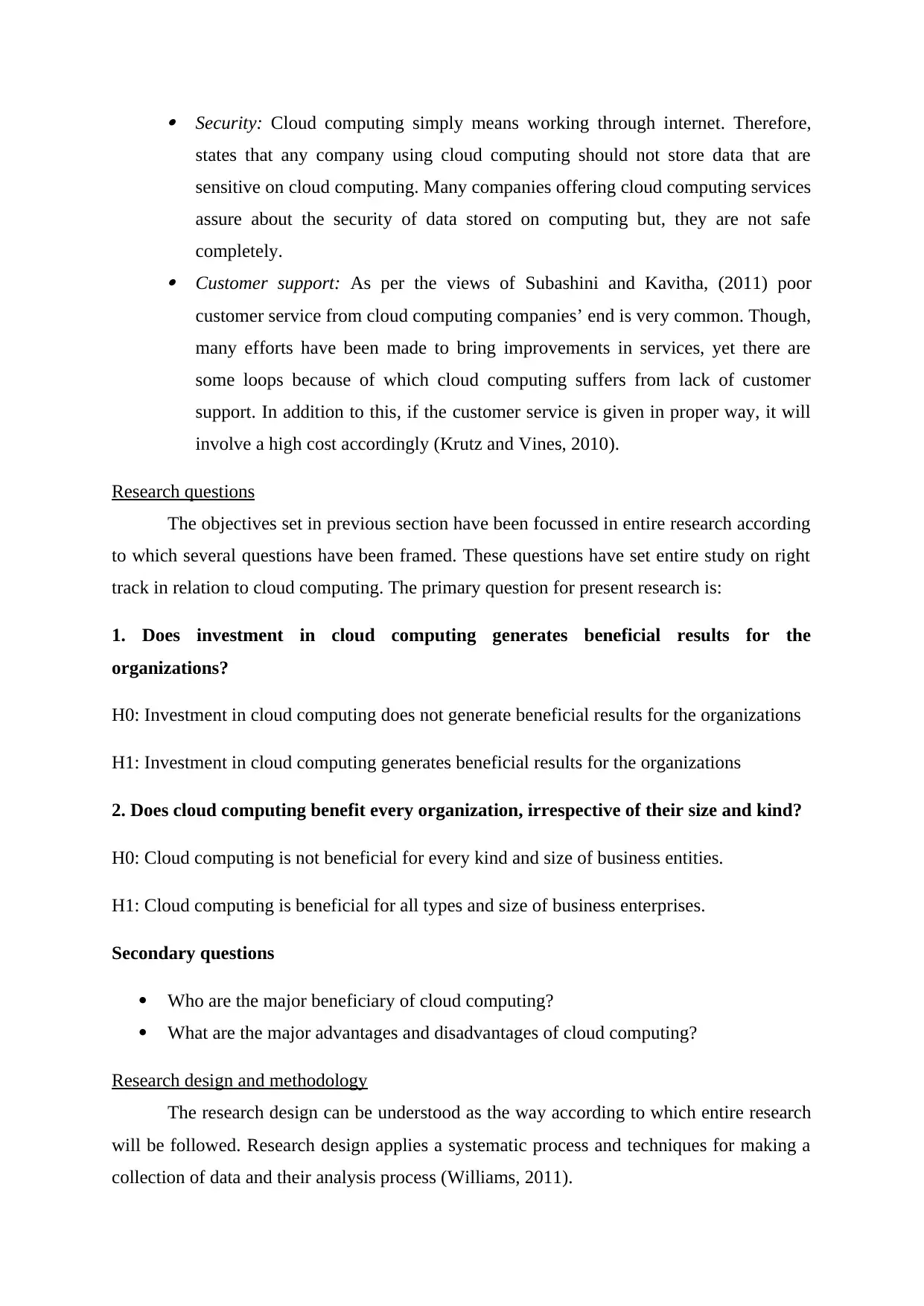
Security: Cloud computing simply means working through internet. Therefore,
states that any company using cloud computing should not store data that are
sensitive on cloud computing. Many companies offering cloud computing services
assure about the security of data stored on computing but, they are not safe
completely.
Customer support: As per the views of Subashini and Kavitha, (2011) poor
customer service from cloud computing companies’ end is very common. Though,
many efforts have been made to bring improvements in services, yet there are
some loops because of which cloud computing suffers from lack of customer
support. In addition to this, if the customer service is given in proper way, it will
involve a high cost accordingly (Krutz and Vines, 2010).
Research questions
The objectives set in previous section have been focussed in entire research according
to which several questions have been framed. These questions have set entire study on right
track in relation to cloud computing. The primary question for present research is:
1. Does investment in cloud computing generates beneficial results for the
organizations?
H0: Investment in cloud computing does not generate beneficial results for the organizations
H1: Investment in cloud computing generates beneficial results for the organizations
2. Does cloud computing benefit every organization, irrespective of their size and kind?
H0: Cloud computing is not beneficial for every kind and size of business entities.
H1: Cloud computing is beneficial for all types and size of business enterprises.
Secondary questions
Who are the major beneficiary of cloud computing?
What are the major advantages and disadvantages of cloud computing?
Research design and methodology
The research design can be understood as the way according to which entire research
will be followed. Research design applies a systematic process and techniques for making a
collection of data and their analysis process (Williams, 2011).
states that any company using cloud computing should not store data that are
sensitive on cloud computing. Many companies offering cloud computing services
assure about the security of data stored on computing but, they are not safe
completely.
Customer support: As per the views of Subashini and Kavitha, (2011) poor
customer service from cloud computing companies’ end is very common. Though,
many efforts have been made to bring improvements in services, yet there are
some loops because of which cloud computing suffers from lack of customer
support. In addition to this, if the customer service is given in proper way, it will
involve a high cost accordingly (Krutz and Vines, 2010).
Research questions
The objectives set in previous section have been focussed in entire research according
to which several questions have been framed. These questions have set entire study on right
track in relation to cloud computing. The primary question for present research is:
1. Does investment in cloud computing generates beneficial results for the
organizations?
H0: Investment in cloud computing does not generate beneficial results for the organizations
H1: Investment in cloud computing generates beneficial results for the organizations
2. Does cloud computing benefit every organization, irrespective of their size and kind?
H0: Cloud computing is not beneficial for every kind and size of business entities.
H1: Cloud computing is beneficial for all types and size of business enterprises.
Secondary questions
Who are the major beneficiary of cloud computing?
What are the major advantages and disadvantages of cloud computing?
Research design and methodology
The research design can be understood as the way according to which entire research
will be followed. Research design applies a systematic process and techniques for making a
collection of data and their analysis process (Williams, 2011).
⊘ This is a preview!⊘
Do you want full access?
Subscribe today to unlock all pages.

Trusted by 1+ million students worldwide
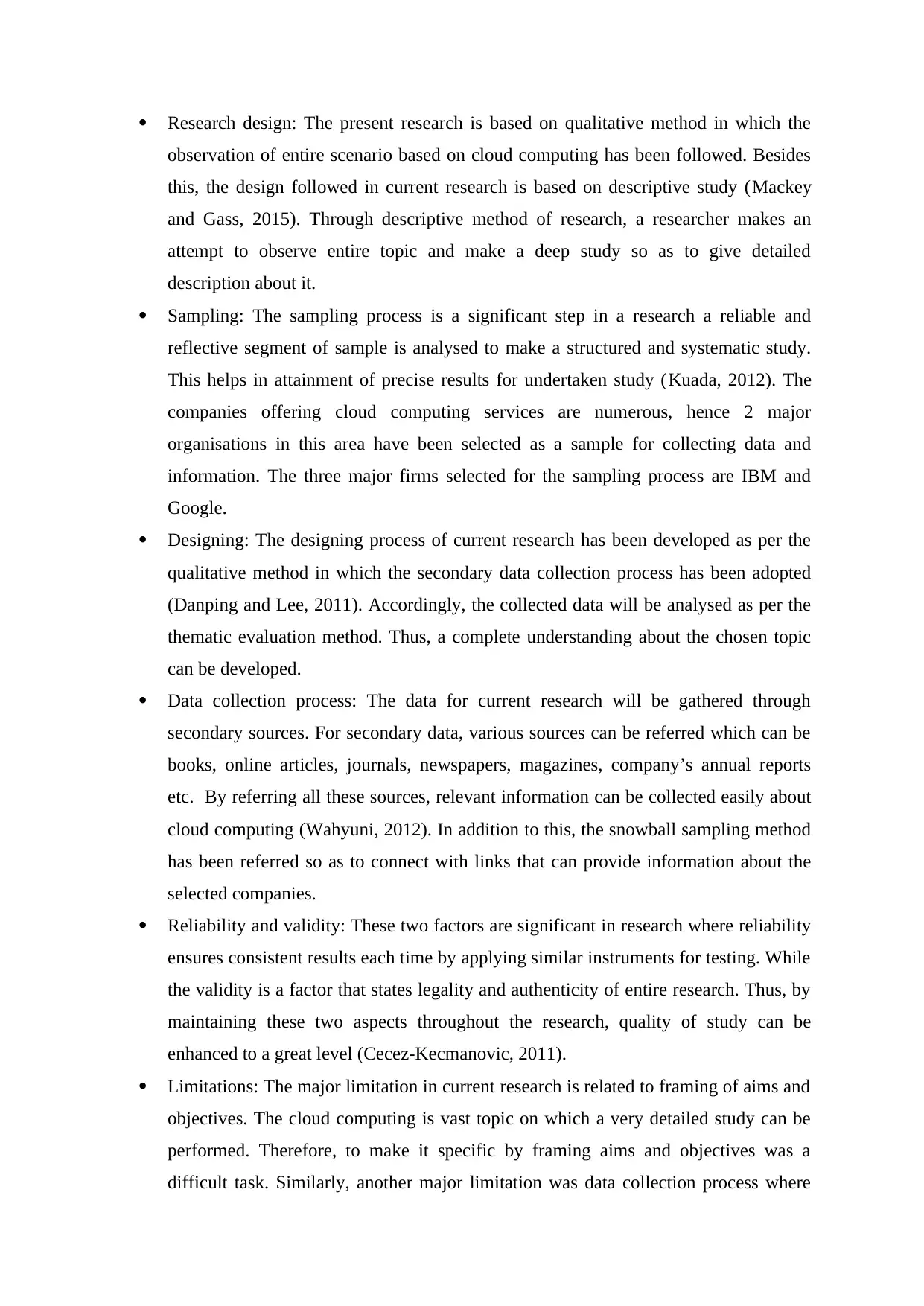
Research design: The present research is based on qualitative method in which the
observation of entire scenario based on cloud computing has been followed. Besides
this, the design followed in current research is based on descriptive study (Mackey
and Gass, 2015). Through descriptive method of research, a researcher makes an
attempt to observe entire topic and make a deep study so as to give detailed
description about it.
Sampling: The sampling process is a significant step in a research a reliable and
reflective segment of sample is analysed to make a structured and systematic study.
This helps in attainment of precise results for undertaken study (Kuada, 2012). The
companies offering cloud computing services are numerous, hence 2 major
organisations in this area have been selected as a sample for collecting data and
information. The three major firms selected for the sampling process are IBM and
Google.
Designing: The designing process of current research has been developed as per the
qualitative method in which the secondary data collection process has been adopted
(Danping and Lee, 2011). Accordingly, the collected data will be analysed as per the
thematic evaluation method. Thus, a complete understanding about the chosen topic
can be developed.
Data collection process: The data for current research will be gathered through
secondary sources. For secondary data, various sources can be referred which can be
books, online articles, journals, newspapers, magazines, company’s annual reports
etc. By referring all these sources, relevant information can be collected easily about
cloud computing (Wahyuni, 2012). In addition to this, the snowball sampling method
has been referred so as to connect with links that can provide information about the
selected companies.
Reliability and validity: These two factors are significant in research where reliability
ensures consistent results each time by applying similar instruments for testing. While
the validity is a factor that states legality and authenticity of entire research. Thus, by
maintaining these two aspects throughout the research, quality of study can be
enhanced to a great level (Cecez-Kecmanovic, 2011).
Limitations: The major limitation in current research is related to framing of aims and
objectives. The cloud computing is vast topic on which a very detailed study can be
performed. Therefore, to make it specific by framing aims and objectives was a
difficult task. Similarly, another major limitation was data collection process where
observation of entire scenario based on cloud computing has been followed. Besides
this, the design followed in current research is based on descriptive study (Mackey
and Gass, 2015). Through descriptive method of research, a researcher makes an
attempt to observe entire topic and make a deep study so as to give detailed
description about it.
Sampling: The sampling process is a significant step in a research a reliable and
reflective segment of sample is analysed to make a structured and systematic study.
This helps in attainment of precise results for undertaken study (Kuada, 2012). The
companies offering cloud computing services are numerous, hence 2 major
organisations in this area have been selected as a sample for collecting data and
information. The three major firms selected for the sampling process are IBM and
Google.
Designing: The designing process of current research has been developed as per the
qualitative method in which the secondary data collection process has been adopted
(Danping and Lee, 2011). Accordingly, the collected data will be analysed as per the
thematic evaluation method. Thus, a complete understanding about the chosen topic
can be developed.
Data collection process: The data for current research will be gathered through
secondary sources. For secondary data, various sources can be referred which can be
books, online articles, journals, newspapers, magazines, company’s annual reports
etc. By referring all these sources, relevant information can be collected easily about
cloud computing (Wahyuni, 2012). In addition to this, the snowball sampling method
has been referred so as to connect with links that can provide information about the
selected companies.
Reliability and validity: These two factors are significant in research where reliability
ensures consistent results each time by applying similar instruments for testing. While
the validity is a factor that states legality and authenticity of entire research. Thus, by
maintaining these two aspects throughout the research, quality of study can be
enhanced to a great level (Cecez-Kecmanovic, 2011).
Limitations: The major limitation in current research is related to framing of aims and
objectives. The cloud computing is vast topic on which a very detailed study can be
performed. Therefore, to make it specific by framing aims and objectives was a
difficult task. Similarly, another major limitation was data collection process where
Paraphrase This Document
Need a fresh take? Get an instant paraphrase of this document with our AI Paraphraser
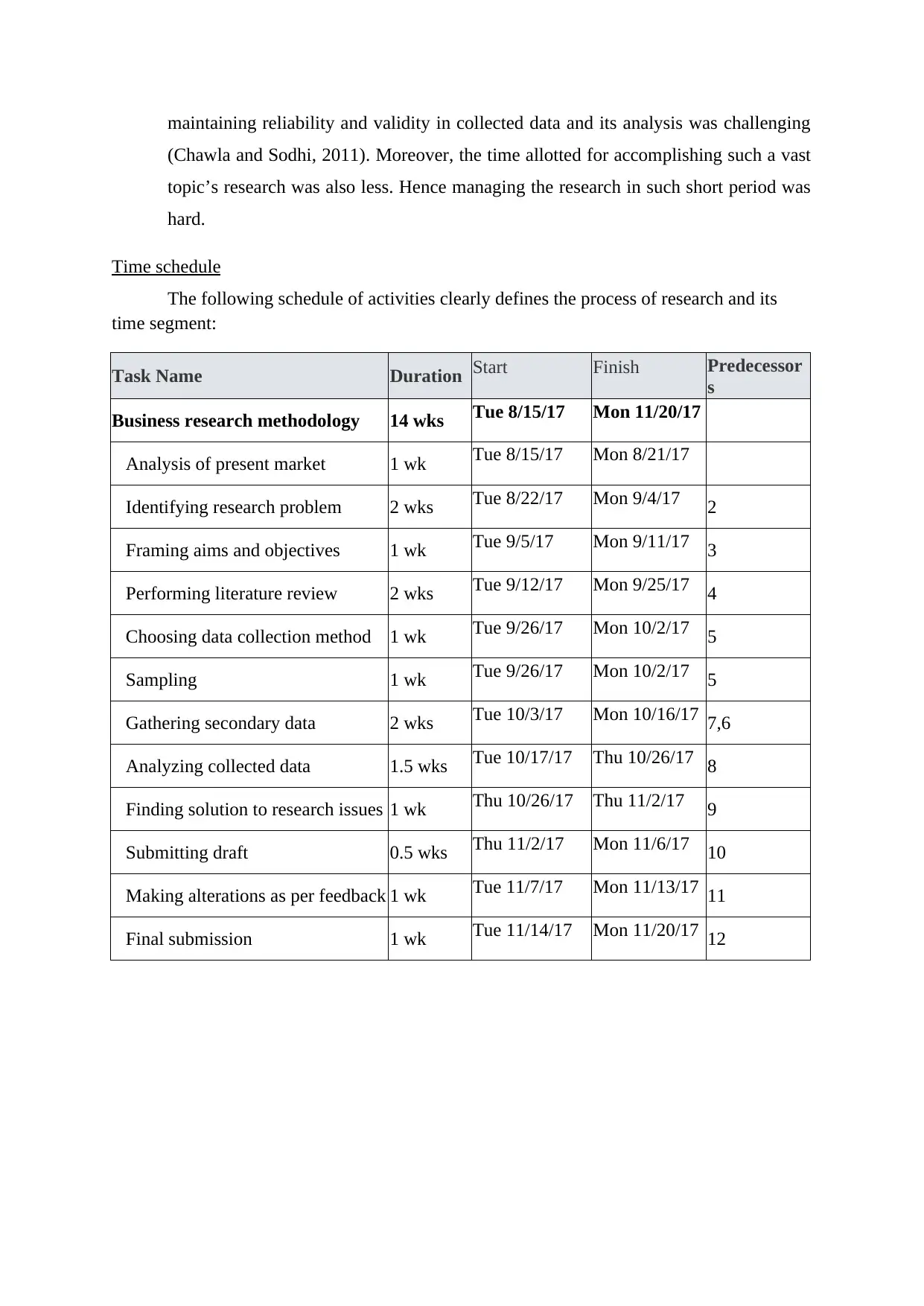
maintaining reliability and validity in collected data and its analysis was challenging
(Chawla and Sodhi, 2011). Moreover, the time allotted for accomplishing such a vast
topic’s research was also less. Hence managing the research in such short period was
hard.
Time schedule
The following schedule of activities clearly defines the process of research and its
time segment:
Task Name Duration Start Finish Predecessor
s
Business research methodology 14 wks Tue 8/15/17 Mon 11/20/17
Analysis of present market 1 wk Tue 8/15/17 Mon 8/21/17
Identifying research problem 2 wks Tue 8/22/17 Mon 9/4/17 2
Framing aims and objectives 1 wk Tue 9/5/17 Mon 9/11/17 3
Performing literature review 2 wks Tue 9/12/17 Mon 9/25/17 4
Choosing data collection method 1 wk Tue 9/26/17 Mon 10/2/17 5
Sampling 1 wk Tue 9/26/17 Mon 10/2/17 5
Gathering secondary data 2 wks Tue 10/3/17 Mon 10/16/17 7,6
Analyzing collected data 1.5 wks Tue 10/17/17 Thu 10/26/17 8
Finding solution to research issues 1 wk Thu 10/26/17 Thu 11/2/17 9
Submitting draft 0.5 wks Thu 11/2/17 Mon 11/6/17 10
Making alterations as per feedback 1 wk Tue 11/7/17 Mon 11/13/17 11
Final submission 1 wk Tue 11/14/17 Mon 11/20/17 12
(Chawla and Sodhi, 2011). Moreover, the time allotted for accomplishing such a vast
topic’s research was also less. Hence managing the research in such short period was
hard.
Time schedule
The following schedule of activities clearly defines the process of research and its
time segment:
Task Name Duration Start Finish Predecessor
s
Business research methodology 14 wks Tue 8/15/17 Mon 11/20/17
Analysis of present market 1 wk Tue 8/15/17 Mon 8/21/17
Identifying research problem 2 wks Tue 8/22/17 Mon 9/4/17 2
Framing aims and objectives 1 wk Tue 9/5/17 Mon 9/11/17 3
Performing literature review 2 wks Tue 9/12/17 Mon 9/25/17 4
Choosing data collection method 1 wk Tue 9/26/17 Mon 10/2/17 5
Sampling 1 wk Tue 9/26/17 Mon 10/2/17 5
Gathering secondary data 2 wks Tue 10/3/17 Mon 10/16/17 7,6
Analyzing collected data 1.5 wks Tue 10/17/17 Thu 10/26/17 8
Finding solution to research issues 1 wk Thu 10/26/17 Thu 11/2/17 9
Submitting draft 0.5 wks Thu 11/2/17 Mon 11/6/17 10
Making alterations as per feedback 1 wk Tue 11/7/17 Mon 11/13/17 11
Final submission 1 wk Tue 11/14/17 Mon 11/20/17 12
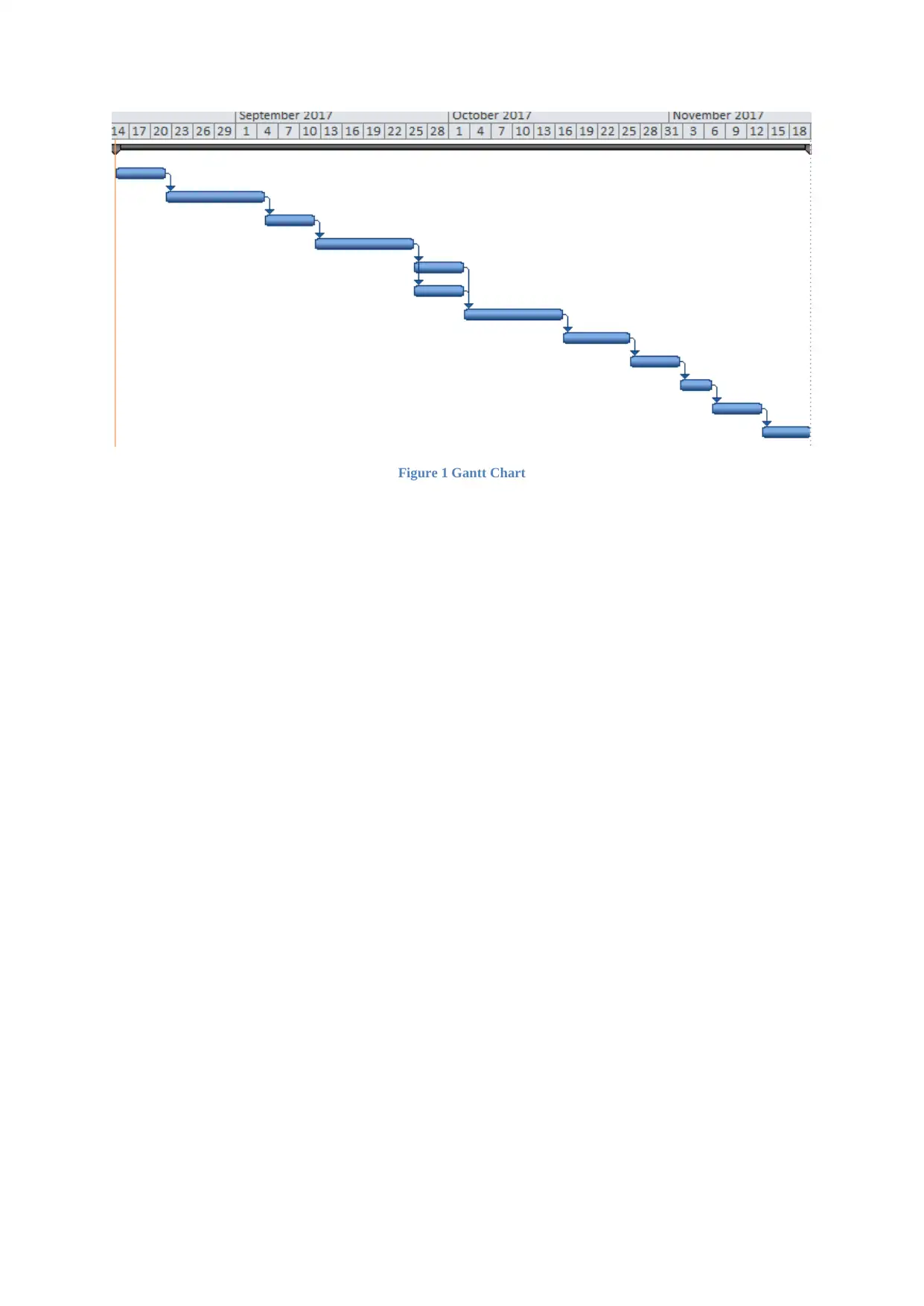
Figure 1 Gantt Chart
⊘ This is a preview!⊘
Do you want full access?
Subscribe today to unlock all pages.

Trusted by 1+ million students worldwide
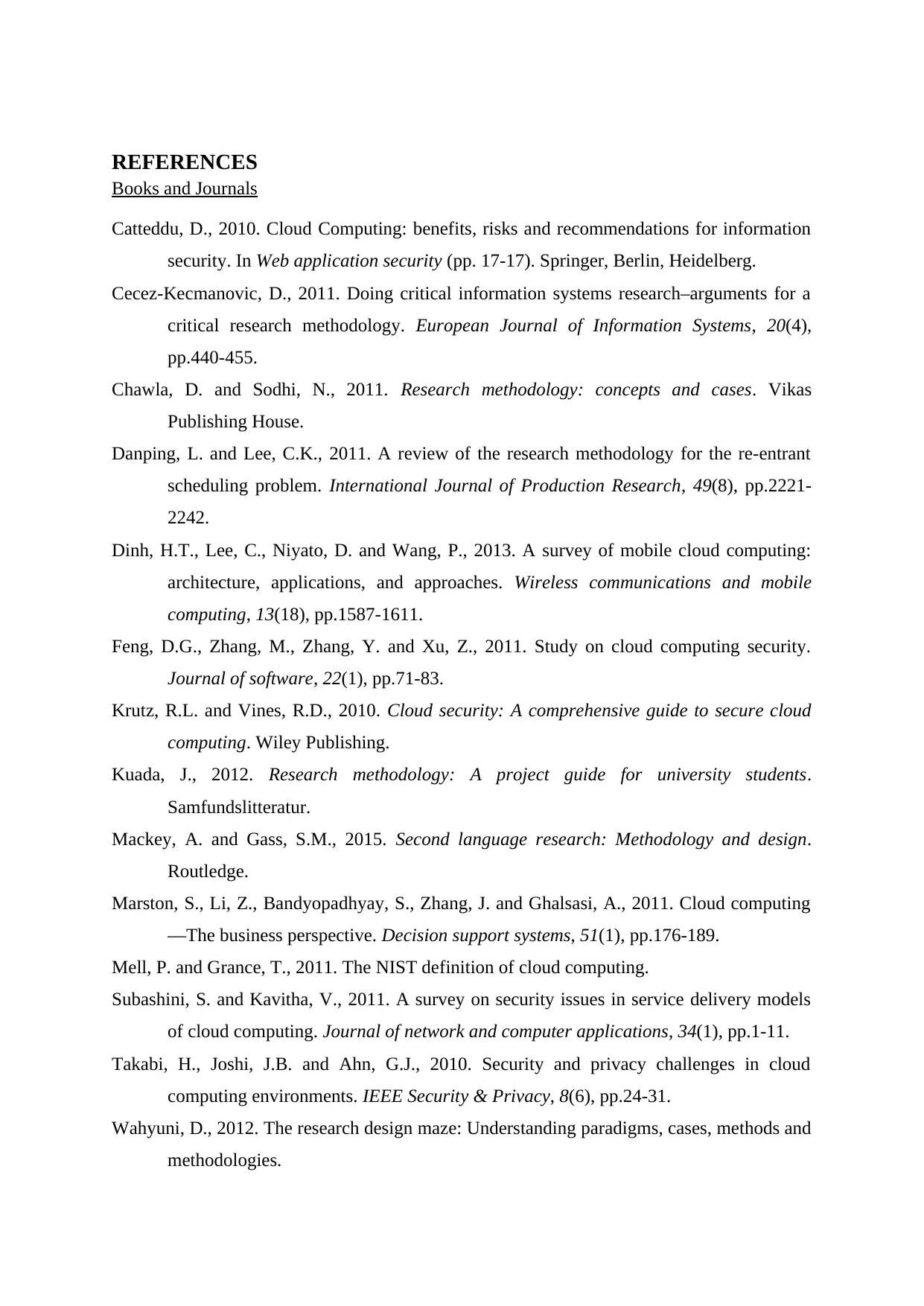
REFERENCES
Books and Journals
Catteddu, D., 2010. Cloud Computing: benefits, risks and recommendations for information
security. In Web application security (pp. 17-17). Springer, Berlin, Heidelberg.
Cecez-Kecmanovic, D., 2011. Doing critical information systems research–arguments for a
critical research methodology. European Journal of Information Systems, 20(4),
pp.440-455.
Chawla, D. and Sodhi, N., 2011. Research methodology: concepts and cases. Vikas
Publishing House.
Danping, L. and Lee, C.K., 2011. A review of the research methodology for the re-entrant
scheduling problem. International Journal of Production Research, 49(8), pp.2221-
2242.
Dinh, H.T., Lee, C., Niyato, D. and Wang, P., 2013. A survey of mobile cloud computing:
architecture, applications, and approaches. Wireless communications and mobile
computing, 13(18), pp.1587-1611.
Feng, D.G., Zhang, M., Zhang, Y. and Xu, Z., 2011. Study on cloud computing security.
Journal of software, 22(1), pp.71-83.
Krutz, R.L. and Vines, R.D., 2010. Cloud security: A comprehensive guide to secure cloud
computing. Wiley Publishing.
Kuada, J., 2012. Research methodology: A project guide for university students.
Samfundslitteratur.
Mackey, A. and Gass, S.M., 2015. Second language research: Methodology and design.
Routledge.
Marston, S., Li, Z., Bandyopadhyay, S., Zhang, J. and Ghalsasi, A., 2011. Cloud computing
—The business perspective. Decision support systems, 51(1), pp.176-189.
Mell, P. and Grance, T., 2011. The NIST definition of cloud computing.
Subashini, S. and Kavitha, V., 2011. A survey on security issues in service delivery models
of cloud computing. Journal of network and computer applications, 34(1), pp.1-11.
Takabi, H., Joshi, J.B. and Ahn, G.J., 2010. Security and privacy challenges in cloud
computing environments. IEEE Security & Privacy, 8(6), pp.24-31.
Wahyuni, D., 2012. The research design maze: Understanding paradigms, cases, methods and
methodologies.
Books and Journals
Catteddu, D., 2010. Cloud Computing: benefits, risks and recommendations for information
security. In Web application security (pp. 17-17). Springer, Berlin, Heidelberg.
Cecez-Kecmanovic, D., 2011. Doing critical information systems research–arguments for a
critical research methodology. European Journal of Information Systems, 20(4),
pp.440-455.
Chawla, D. and Sodhi, N., 2011. Research methodology: concepts and cases. Vikas
Publishing House.
Danping, L. and Lee, C.K., 2011. A review of the research methodology for the re-entrant
scheduling problem. International Journal of Production Research, 49(8), pp.2221-
2242.
Dinh, H.T., Lee, C., Niyato, D. and Wang, P., 2013. A survey of mobile cloud computing:
architecture, applications, and approaches. Wireless communications and mobile
computing, 13(18), pp.1587-1611.
Feng, D.G., Zhang, M., Zhang, Y. and Xu, Z., 2011. Study on cloud computing security.
Journal of software, 22(1), pp.71-83.
Krutz, R.L. and Vines, R.D., 2010. Cloud security: A comprehensive guide to secure cloud
computing. Wiley Publishing.
Kuada, J., 2012. Research methodology: A project guide for university students.
Samfundslitteratur.
Mackey, A. and Gass, S.M., 2015. Second language research: Methodology and design.
Routledge.
Marston, S., Li, Z., Bandyopadhyay, S., Zhang, J. and Ghalsasi, A., 2011. Cloud computing
—The business perspective. Decision support systems, 51(1), pp.176-189.
Mell, P. and Grance, T., 2011. The NIST definition of cloud computing.
Subashini, S. and Kavitha, V., 2011. A survey on security issues in service delivery models
of cloud computing. Journal of network and computer applications, 34(1), pp.1-11.
Takabi, H., Joshi, J.B. and Ahn, G.J., 2010. Security and privacy challenges in cloud
computing environments. IEEE Security & Privacy, 8(6), pp.24-31.
Wahyuni, D., 2012. The research design maze: Understanding paradigms, cases, methods and
methodologies.
Paraphrase This Document
Need a fresh take? Get an instant paraphrase of this document with our AI Paraphraser
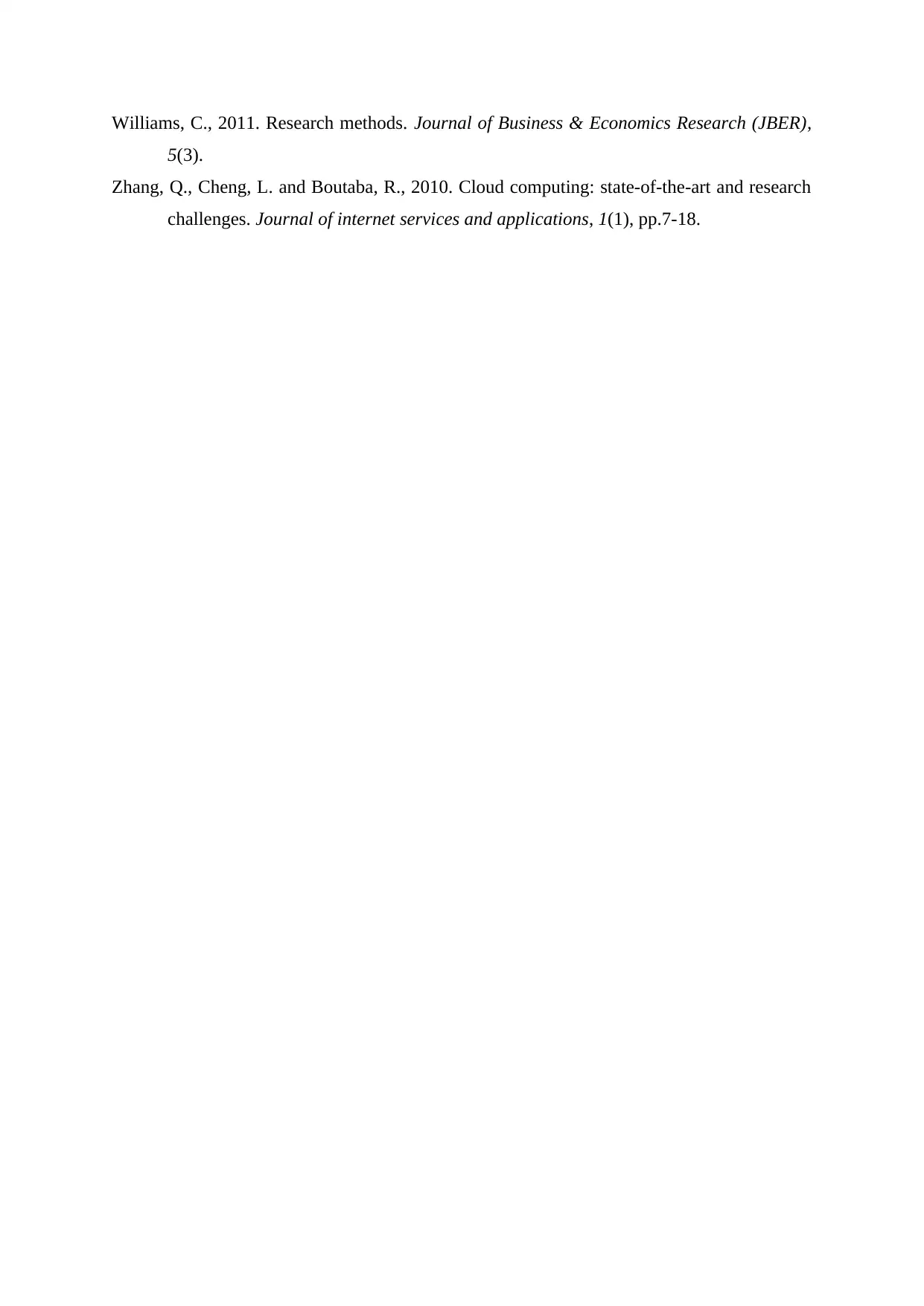
Williams, C., 2011. Research methods. Journal of Business & Economics Research (JBER),
5(3).
Zhang, Q., Cheng, L. and Boutaba, R., 2010. Cloud computing: state-of-the-art and research
challenges. Journal of internet services and applications, 1(1), pp.7-18.
5(3).
Zhang, Q., Cheng, L. and Boutaba, R., 2010. Cloud computing: state-of-the-art and research
challenges. Journal of internet services and applications, 1(1), pp.7-18.
1 out of 11
Related Documents
Your All-in-One AI-Powered Toolkit for Academic Success.
+13062052269
info@desklib.com
Available 24*7 on WhatsApp / Email
![[object Object]](/_next/static/media/star-bottom.7253800d.svg)
Unlock your academic potential
Copyright © 2020–2025 A2Z Services. All Rights Reserved. Developed and managed by ZUCOL.




